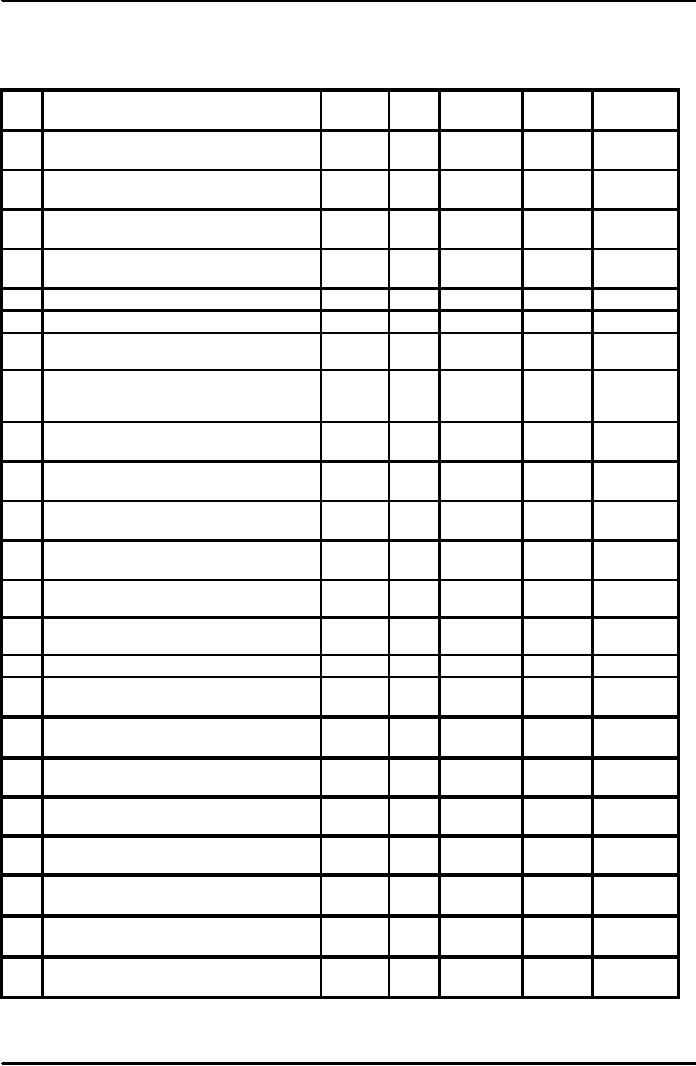 |
MEASUREMENT OF CONCEPTS (CONTINUED):Scales and Indexes |
| << MEASUREMENT OF CONCEPTS (CONTINUED):Operationalization |
| CRITERIA FOR GOOD MEASUREMENT:Convergent Validity >> |

Research
Methods STA630
VU
Lesson
17
MEASUREMENT
OF CONCEPTS (CONTINUED)
STATEMENTS:
No.
Statements
S.
Agree Agree Undecided Disagree S.
Disagree
I
have a good opportunity
for
1
advancement
in my job
I
feel very comfortable with
my co-
2
workers
My
pay is adequate to meet my
necessary
3
expenses
My
work gives me a sense
of
4
accomplishment
5
My
boss is impolite and
cold
6
My
job is a dead-end job
7
The
company of my co-workers is boring
Pay
at my level is less as compared
to
8
other
organizations
Most
of the time I am frustrated with
my
9
work
My
boss praises good work and
is
10
supportive
There
is a chance of frequent
promotions
11
in
my job
My
co-workers are a source of
inspiration
12
for
me
13
I receive reasonable annual
increments
14
My work is very challenging to
me
15
My boss is adept in his
work
We
have an unfair promotion policy
in
16
our
organization
Working
style of my co-workers is
17
different
from mine
18
The old-age benefits are
quite adequate
19
Most of the time I do routine
work
20
My boss does not delegate
powers
Opportunity
for promotion is some-what
21
limited
here
My
co-workers try to take
credit of my
22
work
My
pay is commensurate with
my
23
qualification
52

Research
Methods STA630
VU
Scales
and Indexes
Scales
and indexes are often used
interchangeably. Social researchers do
not use a consistent
nomenclature
to distinguish between the two.
A
scale is a measure in which a
researcher captures the intensity,
direction, level, or potency of
a
variable
construct. It arranges responses or observations on a
continuum or in series of categories.
A
scale
can use a single indicator
or multiple indicators.
An
index is a measure in which a
researcher adds or combines several
distinct indicators of a construct
into
a single score. The composite
scores is often a simple sum
of the multiple indicators. Indexes
are
often
measured at the interval or ratio
level.
Researchers
sometimes combine thee
features of scales and indexes in a
single measure. This
is
common
when a researcher has a several
indicators that are scales
(i.e. that measure intensity
or
direction).
The researcher then adds
these indicators together to
yield a single score,
thereby creating an
index.
Types
of Scales
A
scale refers to any series of items
that are arranged progressively
according to value or
magnitude,
into
which an item can be placed
according to its quantification. In
other words, a scale is a
continuous
spectrum
or series of categories.
It
is traditional to classify scales of
measurement on the basis of the mathematical
comparisons that are
allowable
with these scales. Four
types of scales are nominal,
ordinal, interval, and
ratio.
Nominal
Scale
A
nominal scale is the one in which the
numbers or letters assigned to objects
serve as labels for
identification
or classification. This measurement
scale is the simplest type. With
nominal data, we are
collecting
information on a variable that
naturally or by design can be grouped
into two or more
categories
that are mutually exclusive,
and collectively exhaustive.
Nominal
scales are the least
powerful of the four scales.
They suggest no order or
distance relationship
and
have no arithmetic origin. Nevertheless, if no
other scale can be used,
one can almost always
one
set
of properties into a set of
equivalent classes.
Ordinal
Scale
Ordinal
scales include the characteristics of the
nominal scale plus an
indicator of order. If a
is
greater
than
b
and
b
is
greater than c,
then a
is
greater than c.
The use of ordinal scale
implies a statement of
"greater
than" or "less than" without
stating how much greater or
less. Other descriptors can
be:
"superior
to," "happier than," "poorer
than," or "above."
Interval
Scale
Interval
scales have the power of nominal
and ordinal scales plus
one additional strength:
they
incorporate
the concept of equality of interval
(the distance between 1 and 2
equals the distance between
2
and 3). For example, the
elapsed time between 3 and 6 A. M. equals
the time between 4 and 7 A. M.
One
cannot say, however, 6 A.M. is twice as
late as 3 A.M. because "zero
time" is an arbitrary
origin.
In
the consumer price index, if the
base year is 1983, the price
level during 1983 will be
set arbitrarily as
100.
Although this is an equal
interval measurement scale, the
zero point is
arbitrary.
53

Research
Methods STA630
VU
Ratio
Scale
Ratio
scales incorporate all thee
powers of the previous scales plus the
provision for absolute zero
or
origin.
Ratio data represent the actual
amounts of variable. Measures of
physical dimensions such as
weight,
height, distance, and area
are the examples. The absolute
zero represents a point on the
scale
where
there is an absence of the given
attribute. If we hear that a
person has zero amount of
money, we
understand
the zero value of the amount.
54
Table of Contents:
- INTRODUCTION, DEFINITION & VALUE OF RESEARCH
- SCIENTIFIC METHOD OF RESEARCH & ITS SPECIAL FEATURES
- CLASSIFICATION OF RESEARCH:Goals of Exploratory Research
- THEORY AND RESEARCH:Concepts, Propositions, Role of Theory
- CONCEPTS:Concepts are an Abstraction of Reality, Sources of Concepts
- VARIABLES AND TYPES OF VARIABLES:Moderating Variables
- HYPOTHESIS TESTING & CHARACTERISTICS:Correlational hypotheses
- REVIEW OF LITERATURE:Where to find the Research Literature
- CONDUCTING A SYSTEMATIC LITERATURE REVIEW:Write the Review
- THEORETICAL FRAMEWORK:Make an inventory of variables
- PROBLEM DEFINITION AND RESEARCH PROPOSAL:Problem Definition
- THE RESEARCH PROCESS:Broad Problem Area, Theoretical Framework
- ETHICAL ISSUES IN RESEARCH:Ethical Treatment of Participants
- ETHICAL ISSUES IN RESEARCH (Cont):Debriefing, Rights to Privacy
- MEASUREMENT OF CONCEPTS:Conceptualization
- MEASUREMENT OF CONCEPTS (CONTINUED):Operationalization
- MEASUREMENT OF CONCEPTS (CONTINUED):Scales and Indexes
- CRITERIA FOR GOOD MEASUREMENT:Convergent Validity
- RESEARCH DESIGN:Purpose of the Study, Steps in Conducting a Survey
- SURVEY RESEARCH:CHOOSING A COMMUNICATION MEDIA
- INTERCEPT INTERVIEWS IN MALLS AND OTHER HIGH-TRAFFIC AREAS
- SELF ADMINISTERED QUESTIONNAIRES (CONTINUED):Interesting Questions
- TOOLS FOR DATA COLLECTION:Guidelines for Questionnaire Design
- PILOT TESTING OF THE QUESTIONNAIRE:Discovering errors in the instrument
- INTERVIEWING:The Role of the Interviewer, Terminating the Interview
- SAMPLE AND SAMPLING TERMINOLOGY:Saves Cost, Labor, and Time
- PROBABILITY AND NON-PROBABILITY SAMPLING:Convenience Sampling
- TYPES OF PROBABILITY SAMPLING:Systematic Random Sample
- DATA ANALYSIS:Information, Editing, Editing for Consistency
- DATA TRANSFROMATION:Indexes and Scales, Scoring and Score Index
- DATA PRESENTATION:Bivariate Tables, Constructing Percentage Tables
- THE PARTS OF THE TABLE:Reading a percentage Table
- EXPERIMENTAL RESEARCH:The Language of Experiments
- EXPERIMENTAL RESEARCH (Cont.):True Experimental Designs
- EXPERIMENTAL RESEARCH (Cont.):Validity in Experiments
- NON-REACTIVE RESEARCH:Recording and Documentation
- USE OF SECONDARY DATA:Advantages, Disadvantages, Secondary Survey Data
- OBSERVATION STUDIES/FIELD RESEARCH:Logic of Field Research
- OBSERVATION STUDIES (Contd.):Ethical Dilemmas of Field research
- HISTORICAL COMPARATIVE RESEARCH:Similarities to Field Research
- HISTORICAL-COMPARATIVE RESEARCH (Contd.):Locating Evidence
- FOCUS GROUP DISCUSSION:The Purpose of FGD, Formal Focus Groups
- FOCUS GROUP DISCUSSION (Contd.):Uses of Focus Group Discussions
- REPORT WRITING:Conclusions and recommendations, Appended Parts
- REFERENCING:Book by a single author, Edited book, Doctoral Dissertation